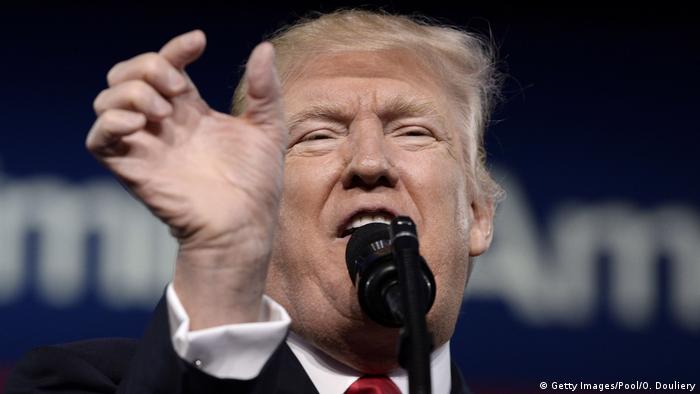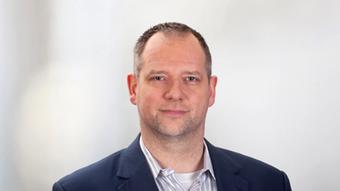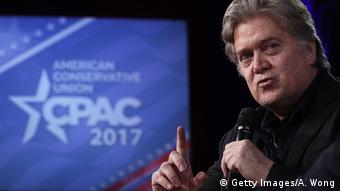Opinion: Trump is following Bannon's agenda
http://www.dw.com/en
The president's attacks on the media are getting more ferocious. He is threatening concrete measures to limit the freedom of the press. This does not bode well, and Carsten von Nahmen thinks it's part of a greater plan.
Donald Trump has doubled down once again. At the annual gathering of the Conservative Political Action Conference (CPAC) - a group with close ties to the Republicans - the US president reiterated his accusation against large parts of the US media, namely that they publish false information or are themselves "fake news" outlets, even an "enemy" of the people.
But that wasn't all. Trump even announced that he would do something to prevent media from basing their reporting on insider sources without naming those contacts. If something like this were really drafted into legislation, it would constitute a major attack on press freedom. Without protection for sources, without anonymous informers and "whistleblowers," the media would not be able to effectively carry out its job - keeping the powerful in check.
Fake and friends
Trump did stress that his attacks were not directed at the media as a whole, that there were "good" examples too. But by "good," the president was referring to those outlets that tend to take his side: for instance, the openly pro-Republican broadcaster Fox News. Trump himself has often singled out the breakfast show Fox and Friends, whose hosts revere the president with a devotion that borders on sycophancy.
Nevertheless, Fox also has some serious anchors who apply their critical faculties to all, like Shephard Smith and Chris Wallace. The channel does at least try to bring in voices from the left and liberal side of the spectrum in measured doses. You can't say that about some of Trump's other media pals like conservative radio crusader Rush Limbaugh. Or there's the even more irate Alex Jones (of Infowars), who propagates conspiracy theories online, on the radio and via video. And of course there is the online platform Breitbart, which was managed for four years by Trump's chief strategist, Steve Bannon. In the 2016 campaign, Breitbart spewed out unfettered pro-Trump propaganda and otherwise promoted itself via sometimes fabricated stories about crimes purportedly committed by migrants in the US or in Europe.
These are the media outlets Trump means when he praises some for being "nice" or "fair" to him. They're the ones he often explicitly cites to try to validate his sometimes crude theories or his alternative facts. All the others, so far as Trump's concerned, are "unfair," or "dishonest" - they're "fake news." Trump's focus here is on the traditional beacons of American print journalism like the New York Times and the Washington Post, or established TV news channels like ABC, NBC or CNN.
The president's attacks on the media are getting more ferocious. He is threatening concrete measures to limit the freedom of the press. This does not bode well, and Carsten von Nahmen thinks it's part of a greater plan.
Donald Trump has doubled down once again. At the annual gathering of the Conservative Political Action Conference (CPAC) - a group with close ties to the Republicans - the US president reiterated his accusation against large parts of the US media, namely that they publish false information or are themselves "fake news" outlets, even an "enemy" of the people.
But that wasn't all. Trump even announced that he would do something to prevent media from basing their reporting on insider sources without naming those contacts. If something like this were really drafted into legislation, it would constitute a major attack on press freedom. Without protection for sources, without anonymous informers and "whistleblowers," the media would not be able to effectively carry out its job - keeping the powerful in check.
Fake and friends
Trump did stress that his attacks were not directed at the media as a whole, that there were "good" examples too. But by "good," the president was referring to those outlets that tend to take his side: for instance, the openly pro-Republican broadcaster Fox News. Trump himself has often singled out the breakfast show Fox and Friends, whose hosts revere the president with a devotion that borders on sycophancy.
Nevertheless, Fox also has some serious anchors who apply their critical faculties to all, like Shephard Smith and Chris Wallace. The channel does at least try to bring in voices from the left and liberal side of the spectrum in measured doses. You can't say that about some of Trump's other media pals like conservative radio crusader Rush Limbaugh. Or there's the even more irate Alex Jones (of Infowars), who propagates conspiracy theories online, on the radio and via video. And of course there is the online platform Breitbart, which was managed for four years by Trump's chief strategist, Steve Bannon. In the 2016 campaign, Breitbart spewed out unfettered pro-Trump propaganda and otherwise promoted itself via sometimes fabricated stories about crimes purportedly committed by migrants in the US or in Europe.
These are the media outlets Trump means when he praises some for being "nice" or "fair" to him. They're the ones he often explicitly cites to try to validate his sometimes crude theories or his alternative facts. All the others, so far as Trump's concerned, are "unfair," or "dishonest" - they're "fake news." Trump's focus here is on the traditional beacons of American print journalism like the New York Times and the Washington Post, or established TV news channels like ABC, NBC or CNN.
Trump: 'Fake news are the enemy of the people'
Making an example
Trump's chief strategist and chief ideologue Bannon hit the same notes at the CPAC conference. Once again, he outlined his belief that it's not the Democrats who are the main opponents of the populist "movement" that swept Trump into the White House. Rather it is the "mainstream media." That's an old conservative dog whistle to refer journalism that's altogether too liberal for their liking.
So it's fitting that on the same day as Trump's CPAC speech, a string of media outlets - including CNN, the New York Times and the liberal online platform Politico - were shut out of a press gaggle at the White House. Taken in isolation it's no scandal, as some such background briefings can have a degree of exclusivity - even if the exclusion of such renowned outlets is somewhat out of the ordinary. But the underlying message was clear: those uncomfortable critics who have brewed up trouble for the administration in recent days with revelation after revelation should be "punished." That is not a good sign.
Resistance from within?
What can only be hoped now is that those among Trump's confidants who are not bent on confrontation can put the brakes on. And no doubt, in the coming days reassurances will follow that no legal measures against the media are in the works - that once again Trump's message was misconstrued.
That would be rather like Defense Secretary Jim Mattis and Vice President Mike Pence's appearances at the Munich Security Conference a few days ago, reassuring NATO allies and generally trying to put the cork back on Trump's description of the defensive alliance as "obsolete."
But was Trump really just shooting drivel from the hip - again? And above all: will his murky eminence Steve Bannon really let it be stopped?
At the end of the day, it is principally Bannon who wants to fundamentally shake up the "Grand Old Party" and ultimately America itself. His tool for these renovations is President Trump, supported by the nationalist "movement" that has been meeting on the outskirts of the capital in the past days. "Nationalist," incidentally, is not a "mainstream-media" exaggeration. Bannon himself often used this term, just like many other CPAC speakers and participants.
And what of the more moderate conservative forces in the Republican Party, in Congress and in the Trump administration? They are playing along in order to realize their political goals, goals that were repeatedly thwarted by Democrat President Barack Obama in recent years.
They had better tread carefully. Bannon and Trump might be hitting the media now, but their target is the entire establishment - including the Republican Party.
Making an example
Trump's chief strategist and chief ideologue Bannon hit the same notes at the CPAC conference. Once again, he outlined his belief that it's not the Democrats who are the main opponents of the populist "movement" that swept Trump into the White House. Rather it is the "mainstream media." That's an old conservative dog whistle to refer journalism that's altogether too liberal for their liking.
So it's fitting that on the same day as Trump's CPAC speech, a string of media outlets - including CNN, the New York Times and the liberal online platform Politico - were shut out of a press gaggle at the White House. Taken in isolation it's no scandal, as some such background briefings can have a degree of exclusivity - even if the exclusion of such renowned outlets is somewhat out of the ordinary. But the underlying message was clear: those uncomfortable critics who have brewed up trouble for the administration in recent days with revelation after revelation should be "punished." That is not a good sign.
Resistance from within?
What can only be hoped now is that those among Trump's confidants who are not bent on confrontation can put the brakes on. And no doubt, in the coming days reassurances will follow that no legal measures against the media are in the works - that once again Trump's message was misconstrued.
That would be rather like Defense Secretary Jim Mattis and Vice President Mike Pence's appearances at the Munich Security Conference a few days ago, reassuring NATO allies and generally trying to put the cork back on Trump's description of the defensive alliance as "obsolete."
But was Trump really just shooting drivel from the hip - again? And above all: will his murky eminence Steve Bannon really let it be stopped?
At the end of the day, it is principally Bannon who wants to fundamentally shake up the "Grand Old Party" and ultimately America itself. His tool for these renovations is President Trump, supported by the nationalist "movement" that has been meeting on the outskirts of the capital in the past days. "Nationalist," incidentally, is not a "mainstream-media" exaggeration. Bannon himself often used this term, just like many other CPAC speakers and participants.
And what of the more moderate conservative forces in the Republican Party, in Congress and in the Trump administration? They are playing along in order to realize their political goals, goals that were repeatedly thwarted by Democrat President Barack Obama in recent years.
They had better tread carefully. Bannon and Trump might be hitting the media now, but their target is the entire establishment - including the Republican Party.
The president's attacks on the media are getting more ferocious. He is threatening concrete measures to limit the freedom of the press. This does not bode well, and Carsten von Nahmen thinks it's part of a greater plan.
Donald Trump has doubled down once again. At the annual gathering of the Conservative Political Action Conference (CPAC) - a group with close ties to the Republicans - the US president reiterated his accusation against large parts of the US media, namely that they publish false information or are themselves "fake news" outlets, even an "enemy" of the people.
But that wasn't all. Trump even announced that he would do something to prevent media from basing their reporting on insider sources without naming those contacts. If something like this were really drafted into legislation, it would constitute a major attack on press freedom. Without protection for sources, without anonymous informers and "whistleblowers," the media would not be able to effectively carry out its job - keeping the powerful in check.
Fake and friends
Trump did stress that his attacks were not directed at the media as a whole, that there were "good" examples too. But by "good," the president was referring to those outlets that tend to take his side: for instance, the openly pro-Republican broadcaster Fox News. Trump himself has often singled out the breakfast show Fox and Friends, whose hosts revere the president with a devotion that borders on sycophancy.
Nevertheless, Fox also has some serious anchors who apply their critical faculties to all, like Shephard Smith and Chris Wallace. The channel does at least try to bring in voices from the left and liberal side of the spectrum in measured doses. You can't say that about some of Trump's other media pals like conservative radio crusader Rush Limbaugh. Or there's the even more irate Alex Jones (of Infowars), who propagates conspiracy theories online, on the radio and via video. And of course there is the online platform Breitbart, which was managed for four years by Trump's chief strategist, Steve Bannon. In the 2016 campaign, Breitbart spewed out unfettered pro-Trump propaganda and otherwise promoted itself via sometimes fabricated stories about crimes purportedly committed by migrants in the US or in Europe.
These are the media outlets Trump means when he praises some for being "nice" or "fair" to him. They're the ones he often explicitly cites to try to validate his sometimes crude theories or his alternative facts. All the others, so far as Trump's concerned, are "unfair," or "dishonest" - they're "fake news." Trump's focus here is on the traditional beacons of American print journalism like the New York Times and the Washington Post, or established TV news channels like ABC, NBC or CNN.
Making an example
Trump's chief strategist and chief ideologue Bannon hit the same notes at the CPAC conference. Once again, he outlined his belief that it's not the Democrats who are the main opponents of the populist "movement" that swept Trump into the White House. Rather it is the "mainstream media." That's an old conservative dog whistle to refer journalism that's altogether too liberal for their liking.
So it's fitting that on the same day as Trump's CPAC speech, a string of media outlets - including CNN, the New York Times and the liberal online platform Politico - were shut out of a press gaggle at the White House. Taken in isolation it's no scandal, as some such background briefings can have a degree of exclusivity - even if the exclusion of such renowned outlets is somewhat out of the ordinary. But the underlying message was clear: those uncomfortable critics who have brewed up trouble for the administration in recent days with revelation after revelation should be "punished." That is not a good sign.
Resistance from within?
What can only be hoped now is that those among Trump's confidants who are not bent on confrontation can put the brakes on. And no doubt, in the coming days reassurances will follow that no legal measures against the media are in the works - that once again Trump's message was misconstrued.
That would be rather like Defense Secretary Jim Mattis and Vice President Mike Pence's appearances at the Munich Security Conference a few days ago, reassuring NATO allies and generally trying to put the cork back on Trump's description of the defensive alliance as "obsolete."
But was Trump really just shooting drivel from the hip - again? And above all: will his murky eminence Steve Bannon really let it be stopped?
At the end of the day, it is principally Bannon who wants to fundamentally shake up the "Grand Old Party" and ultimately America itself. His tool for these renovations is President Trump, supported by the nationalist "movement" that has been meeting on the outskirts of the capital in the past days. "Nationalist," incidentally, is not a "mainstream-media" exaggeration. Bannon himself often used this term, just like many other CPAC speakers and participants.
And what of the more moderate conservative forces in the Republican Party, in Congress and in the Trump administration? They are playing along in order to realize their political goals, goals that were repeatedly thwarted by Democrat President Barack Obama in recent years.
They had better tread carefully. Bannon and Trump might be hitting the media now, but their target is the entire establishment - including the Republican Party.



Comments